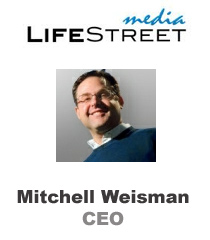 LifeStreet Media has, to this point in its trajectory, been focused on driving app installs through mobile and social ad placements. Its optimization engine, RevJet, claims to dramatically improve ad performance for its core customer base of app developers and publishers. But lately it’s begun to focus more on serving “true campaign objectives” rather than strictly driving downloads.
LifeStreet Media has, to this point in its trajectory, been focused on driving app installs through mobile and social ad placements. Its optimization engine, RevJet, claims to dramatically improve ad performance for its core customer base of app developers and publishers. But lately it’s begun to focus more on serving “true campaign objectives” rather than strictly driving downloads.
With a recent $66 million investment round, AdExchanger figured it was a good time to check in with the company. Below CEO Mitchell Weisman talks about RevJet, the app marketing opportunity, and what the company plans to do with its new moolah.
AdExchanger: Is it fair to characterize LifeStreet as a social/mobile ad network?
MW: Not really. While we certainly turn ad space into revenue like ad networks [do], LifeStreet Media is a technology company, not an ad network. I say this because ad networks are typically just outsourced sales forces that sell advertising space without adding any proprietary value, whereas LifeStreet actually takes responsibility for creating and optimizing the ads themselves, as well as optimizing many other digital revenue drivers using a brand new kind of revenue maximization technology we’ve developed.
We’ve invested over $25 million developing our optimization platform, called RevJet, which is built upon some technology we’ve invented called universal object serving. Universal object serving is transformative technology for optimization, because it enables iterative high velocity testing for any digital revenue driver. These digital revenue drivers range from visual objects, such as colors contained in ads and landing pages (should an ad be blue, green, or black; should the call-to-action say “click here” or “click now;” should the image be a horse, a man on a horse, or two horses), to logical objects, such as trafficking decisions and revenue maximization algorithms (should we target by day, hour, week, or month; should we go by ABC, BCD or CDF algorithm).
With universal object serving, RevJet is changing the optimization landscape in myriad ways. Whereas testing has traditionally been a panel-based, episodic, one test at a time exercise, RevJet allows testing to become a perpetual ‘way of life’ that never ends. Traditional testing has been ‘sample based’, where you’re only able to use five percent or 10 percent of your impressions to conduct a single test, RevJet literally allows you to use more than 100 percent of your impressions for testing perpetually – because each impression can and often does participate in multiple parallel tests at the same time, so visual and logical objects are continuously tested and improved to create the highest revenue-producing ads.
This has profound impact for advertisers and publishers. For advertisers this means that we’re so confident in our ability to deliver results that we’re able to offer essentially risk-free performance pricing. They don’t pay until we deliver results. Even ad creation is free. And for publishers this means that an impression is literally worth more with LifeStreet. So getting back to your original question about ad networks, LifeStreet is fundamentally unlike ad networks because we’re not just connecting advertisers and publishers without creating value in the middle. LifeStreet actually increases the value of the ad impressions we touch.
$66 million feels like a lot of money for any ad company. What justifies the big round and what will you spend all that money on?
The value of the company is tied to the opportunities associated with the markets in which we operate, as well as the value of the RevJet technology platform. The potential applications for this technology are vast – and go beyond what we do today.
As for the $66 million, the terms of the investment provided for capital both to fuel growth in the company and to facilitate liquidity for shareholders.
This year the company is investing in three core areas: our market-leading social in-app ad business, our rapidly growing mobile in-app ad business, and our core RevJet technology platform.
Can you say who some of your biggest advertisers have been? How has the profile of your top advertisers changed over time, and what are their typical campaign objectives?
Our advertiser stable includes 200 direct advertisers – plus considerably more advertisers who buy inventory via our Exchange, currently in beta – and they’ve ranged from gaming companies like Zynga and GameDuell to social connectors like Classmates. Many advertisers are app developers hoping to gain users, but some of them just want to use apps as a medium for customer acquisition. The common denominator among all of our advertisers, though, is their objective for performance advertising. Our advertisers want to use in-app advertising to generate customers, and we’ve been able to do that to the tune of 200 million app downloads.
A trend we’ve been delighted by recently has been an increasing willingness by advertisers to partner with us on their true campaign objectives. Most advertisers don’t just want app downloads (and they certainly don’t want clicks on an ad); they want customers, but what defines a customer is different per advertiser. These days an increasing number of our advertisers are working with us to determine — and pay for results – based on such campaign objectives as cost per tutorial completed, cost per returning user, cost per user converted into paying customer, and so forth. We enjoy these types of campaigns since they enable us to deliver higher impact results to our advertising partners.
You make a point of calling out that you’ve powered over 200 million app installs. About what percentage of your ad buyers are primarily pushing apps — be they Android, iOS or social?
Today many, but not all, of our direct advertisers are promoting apps. There’s a bigger range with advertisers in our Exchange, where we see more of a mix of app advertisers and web and branded advertisers.
When does the app marketing opportunity level off? Or do you think it’s just up-and-up from here?
We think the app marketing opportunity is nearly boundless. Borrell Associates expects the mobile in-app advertising opportunity to reach $8 billion by 2015, and eMarketer predicts that social advertising will reach $8 billion by 2012. That said, despite the incredibly large opportunity that exists with apps, our technology is so powerful that there will be other markets of consequence to which I believe we’ll apply it in the future.
How do you overcome the limits on cookie-based ad targeting in mobile and social environments? What progress have you seen in these areas?
Cookie-based targeting in social media has no more limitations than it does on the broader web. That said, there are no cookies in mobile apps, which creates challenges for networks that rely heavily on cookie-based targeting. As a performance-focused network, LifeStreet thrives in this kind of environment. Our core customers, many of which are mobile app developers, are looking to drive massive distribution of their apps to reach to the top of the charts. To do so, they need to run broad campaigns that attract a wide variety of demographics, while continuously refreshing and optimizing their ad creatives.
What’s the ad sales model — direct sales or self-serve, or some blend of the two? And what are your pricing models?
It’s different for advertisers and publishers, and for our mobile and social businesses. Many advertisers opt for the direct model, so we can work with them to identify the appropriate campaign type, learn about their brand considerations, and determine the appropriate success metrics for their unique business needs. Many publishers, especially in our social business, opt for a self-serve model, and they’re often able to set themselves up within a few minutes and receive their first payment within a couple of weeks.
By Zach Rodgers
Follow LifeStreet Media (@lifestreetmedia) and AdExchanger (@adexchanger) on Twitter.













